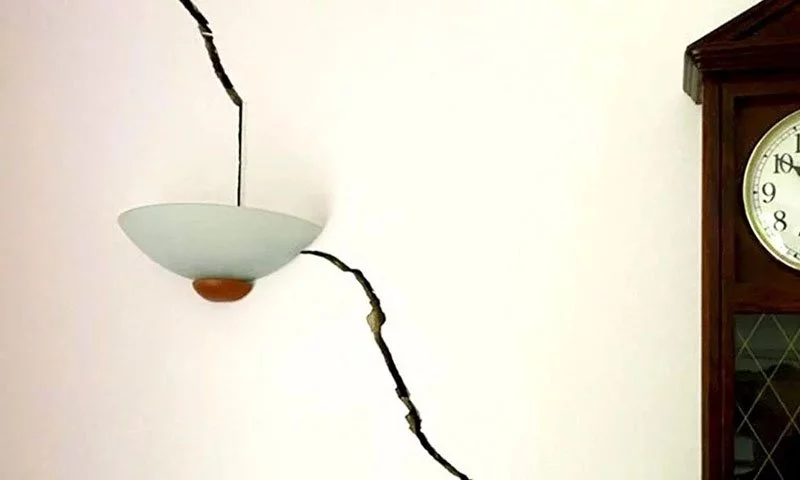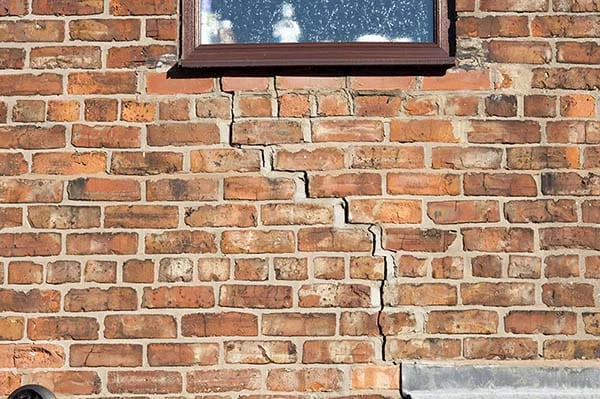Subsidence Service
What Is Subsidence?
Subsidence is the sinking or downward settling of a build’s foundation, or in other words, its ground surface.
In addition, subsidence is known to occur with little to no horizontal movement and can occur at different rates meaning a property’s foundation can become misaligned.
Subsidence is problematic as it is likely to severely impact the stability of a build’s foundation in a detrimental manner.

What Does Subsidence Look Like?
Subsidence can be identified via the sloping of or cracks in joints, bricks, doors, window frames, walls, ceilings and floors.
A further sign of subsidence is the general sloping of the property to one side.
In addition, it is worth knowing that cracks caused by subsidence are likely to be diagonal and wider at the top than the bottom, wider than 3mm (width of a 10p coin), visible from both the outside and inside of a wall and located close to a window or door.
However, if concerned over possible subsidence it is important to get in contact with industry professionals such as us seeing that the identification of subsidence is not always straight forward.

What Causes Subsidence?
Subsidence is caused by the downward movement of the ground on which a property is located which occurs because the soil beneath the build’s foundation is unstable. In the case of subsidence, soil often becomes unstable due to a variety of reasons:
- Trees – tree roots located near the property may dry out the soil by draining its moisture and thus rendering it to sink.
- Environmental Conditions – changes in environmental conditions such as droughts or floods may negatively impact soil by either drying it out or washing it away.
- Clay – clay soil is very prone to weather changes given that it is known to crack and shift when the weather becomes hot and dry which makes it more prone to sinking as a result.
- Leaks – having soil exposed to a water source such as a leak will likely soften it and end up washing it away which may cause sinking.
- Construction – the type of construction of a property may likewise cause subsidence to its foundation. Older properties such as period houses are more likely to have subsidence occur to them as they tend to have shallower foundations. In the same vein, however, these properties are also usually built from bricks and lime mortar which makes them less likely to be susceptible damage from moving ground conditions.
- Location – a property located near areas such as a former quarry or pit is likely to have been constructed on soil which over time becomes unstable due to the activity occurring on these sites.
How To Repair Subsidence?
If you are concerned over your property and suspect it being prey to subsidence, the first thing to do is consult a surveyor.
You will need industry professionals such as ourselves to be able to assess the situation and provide a comprehensive report on the condition of your home’s foundations.
If subsidence is identified by your surveyors, the remedial work necessary will depend on the degree of damage the subsidence has caused and the root cause of it.
For example, if subsidence is being caused by the roots of a nearby tree, it is most likely the tree will have to be moved. If leaky pipework has instead caused your subsidence, it will have to be fixed.
When subsidence is severe, your property is likely to have to be underpinned via traditional mass concrete underpinning methods.
For a free consultation and quotation regarding your subsidence damage please feel free to get in touch with one of our industry leading experts.
How Serious Is Subsidence?
Subsidence is quite a severe issue given that it directly affects the foundations of a property – the very thing which gives its structure strength, stability and support.
When this is compromised, the house is subject to partial collapse which is an extremely dangerous occurrence.
In addition, the longer subsidence is left untreated the worse the damage becomes and the harder it is to repair.
Subsidence should thus be remedied as soon as it is identified and by industry professionals given the gravity of this form of damage.
For further information regarding the extent to which your property’s foundation is potentially damaged or for a better understanding of whether your foundation is experiencing subsidence, please feel free to get in contact with our specialist team who are able to provide you with a free consultation and quotation today!
Will Subsidence Devalue My House?
If subsidence is not effectively treated or treated at all, the value of a property is likely to fall by approximately 20%.
In addition, a build which has suffered from subsidence is unlikely to be able to get a mortgage.
It is also important for buyers to understand whether a property has a history of subsidence.
However, if subsidence is appropriately and effectively remedied, a property should have less issues in regard to its value and ease of being sold.
More dramatically, if your building has drips and puddles of water or similar wet substances, you may also want to investigate whether the structure is suffering from this form of damp.
Penetrating damp, although common, can be quite challenging to identify.
For further information regarding the identification of whether your build is experiencing penetrating damp, please feel free to get in contact with our friendly and expert team who are here to provide you with a free consultation and quotation today!
How To Prevent Subsidence?
A key aspect of preventing subsidence is ensuring there are not any trees too close to your property.
Each different type of tree has a specific recommended minimum distance it should sit from your house.
This can be seen on the Association of British Insurers’ Protecting Your Home From Subsidence Damage.
It is important to note that if you have identified a tree which may be located in a place which is likely to cause subsidence, do not dig it up.
This is likely to cause water logging or instability is not done correctly. Instead, make sure you contact a tree surgeon for advice.
In addition, ensure external plumbing, guttering and pipework are carefully maintained as a means to avoid leaks.
In the same vein, make sure you catch rainwater in appropriate equipment such as barrels to avoid the soil under your foundation washing away.
Don’t worry, you can use this collected water to water your garden for example so it doesn’t have to go to waste!
Structural Repairs are a leading global specialist